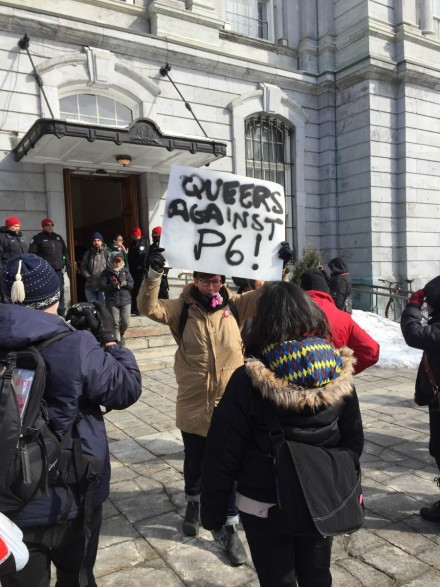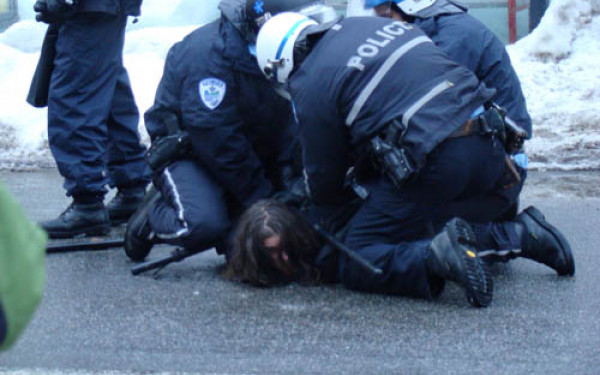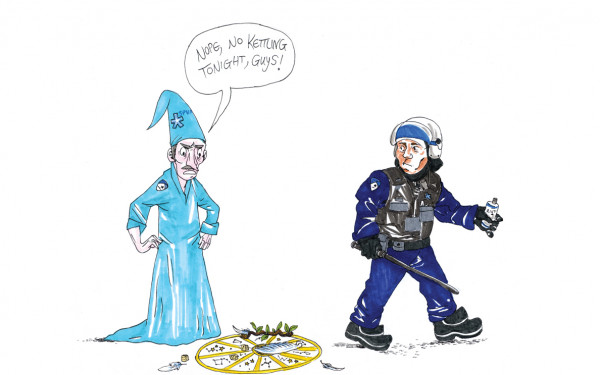Protesting P-6 on the Streets and in Court
As protest season begins, the city’s controversial law comes under fire again
On April 5, 2013, Rima Athar, Jess Dorrance and Helen Bradley went to a demonstration against Montreal’s controversial bylaw P-6. It lasted 10 minutes.
“We walked around Berri square one and a half times,” Dorrance said.
In attendance with over 200 people, the three demonstrators that day were caught in a kettle. The “chilling” sight of police with full riot gear and tear gas launchers led many protesters to stop before they even began. An attendee of many demos, Athar says that the April 5 demonstration featured the most officers she’d ever seen present at once.
It’s March 5, 2015 and Athar, Dorrance and Bradley exit municipal court, chanting and blowing klaxons while holding a “Queers Against P-6” sign alongside dozens of other celebrators. The joyous scene is in response to the cancellation of tickets from years past given under P-6.
Early last month, Montreal municipal courts ruled that fines three protesters received under P-6, a bylaw which declares demonstrations illegal if a routed itinerary is not provided and facemasks are used, were invalid. Eric Thibeault Jolin, Patrick René and A.K. (a minor at the time) were the defendants in a case overseen by Judge Randall Richmond.
That senior officers trivialized the violation of the law was “staggering,” Richmond wrote in a statement from his decision. He added that thousands of annual penal prosecutions could be undermined if this is how ordered procedures are carried out.
Although Richmond also called the bylaw “flawed,” Mayor Denis Coderre supported the rule, tweeting in February that it was the application, rather than the law itself, that was problematic. The police ticketing techniques under question included what Athar, Dorrance, Bradley and others have called “an assembly line.”
At the April 2013 demo, after two-plus hours in freezing weather, the three protesters said that STM buses arrived to act as “processing centres” for P-6 tickets. In principle, a fine under this bylaw is equivalent to a parking ticket, as it is not a criminal charge. A main reason judges acquitted thousands of fines was that many of the officers formally distributing the ticket were not eyewitnesses to the alleged offences.
“Certainly [it was] not someone who could appear as a witness in court to say they saw any of these individuals—let alone all of them—commit the offence,” said Kevin Paul about the actual individual who fined him under the pretense of P-6.
A member of Association pour une solidarité syndicale étudiante (ASSÉ), Paul said he also attended the April 2013 demonstration and received a ticket. He called the assembly line system used that day “efficient,” as there was an officer at each window of the bus doing a different task in the fining process.
Already fined from this protest and one in 2012, Paul said his third formal offence on May 1, 2013 was where the Service de police de la Ville de Montréal enacted the most infringements. After waiting in a kettle for six hours protesters proceeded in buses, while restrained with plastic tie wraps, to an operational centre.
The police photographed them without criminal charges, and Paul said that the person handing out the ticket was not present during the arrests. A P-6 fine can range from $500 to $3000. Paul said a “big part” of the cancellation of P-6 fines were legal clinics, like ones hosted by QPIRG-Concordia called “Contempt of Court.”
Open to anyone who is facing a legal offence or who wants to make a complaint about the police or sue the city, these clinics allow for the sharing of knowledge, skills and experiences, according to Paul.
The network of mutual support and solidarity enabled many self-represented accused to defeat the city of Montreal in court, Paul added. He is not optimistic, however, that the bylaw will be repealed by city officials following these victories.
“I am hopeful that through the actions of the protesters in the streets and in court, we can ultimately make P-6 unenforceable as a tool for shutting down demonstration,” he said.
On November 20, 2013, Solidarity Across Borders posted a community statement on their website in response to an earlier City Hall decision that year to uphold the contentious bylaw, a statement which was endorsed by 86 groups.
Jaggi Singh, a member of QPIRG Concordia and noted activist within the community, says that Montreal would have to quadruple its number of officers to successfully uphold the bylaw.
“We would have to become a police state in order to have the law applied like Coderre implied,” he said about needing to have officers watching people at all times.
A recipient of a ticket through the P-6 bylaw in a June 2012 protest, Singh says that the municipal court system was overwhelmed and could not handle the amount of trials, some of which were taking years to happen.
“It’s very rare things go to trial,” he said. “ We were going to push trials for dozens and dozens of cases.”
Mass arrests in the ‘90s and early 2000s were unsuccessful because people were charged criminally through offences like illegal assembly, mischief and disturbing the peace, and prosecutions were difficult to enact, according to Singh.
P-6, however, which he emphasized was equivalent to a speeding ticket and had minimal consequences, allows for the police to stop peaceful assembly more easily. “No one’s surprised if you catch someone breaking a window and you charge them,” Singh said, explaining that most assemblies are peaceful and without cause for cessation.
It’s protest season in Montreal, and the city is waiting to see how the SPVM will handle it. Singh says he can’t speculate. “I don’t know,” he said in response to a question about how police will navigate the bylaw in light of the recent decisions.





_600_375_90_s_c1.jpg)
2_600_375_90_s_c1.jpg)